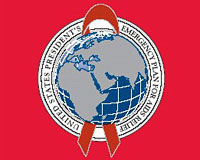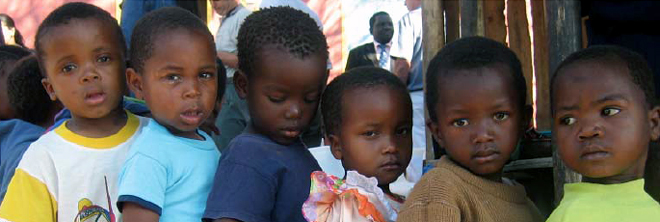| Orphans and Vulnerable Children (Updated February 2008) PDF version PDF version
 |
President George W. Bush's
Emergency Plan for AIDS
Relief is the largest commitment
ever by any nation for an
international health
initiative dedicated to
a single disease-- a
five-year, $15 billion,
comprehensive approach to
combating the disease
around the world.
U.S. Department of
State
U.S. Agency for
International
Development
U.S. Department of
Defense
U.S. Department of
Commerce
U.S. Department of
Labor
U.S. Department of
Health and Human
Services
Peace Corps
Mailing address:
SA-29, 2nd Floor
2201 C Street, NW
Washington, DC 20522-2920
www.PEPFAR.gov
| |

Orphans and Vulnerable Children
The U.S. President’s Emergency Plan for AIDS Relief (Emergency Plan/PEPFAR) supports varied interventions to help families, communities and governments to care for children living with and affected by HIV/AIDS. Over 14 million children have lost one or both parents to HIV/ AIDS. These numbers will almost double over the next 10 years. Support for these orphans and vulnerable children (OVCs) is critical and PEPFAR programs include: caregiver training, support for access to education, economic support, targeted food and nutritional support, legal aid, medical care, psychological and emotional care, and other social and material support.
|
The Power of Partnerships:
As the numbers of OVCs continue to grow, the Emergency Plan is urgently scaling up support for effective interventions, particularly in the 15 focus countries of the Emergency Plan in Africa, Asia and the Caribbean.
- Through fiscal year (FY) 2007, PEPFAR supported care for more than 2.7 million orphans and vulnerable children.
- Through September 30, 2007, of the people receiving antiretroviral treatment through direct U.S. Government (USG) support in the focus countries, nearly 86,000 are children age 14 and under; a 77 percent increase over the number of children on PEPFAR-supported treatment in 2006.
- To lay the foundation for a sustainable response, through September 30, 2007, PEPFAR supported training or retraining of approximately 455,600 individuals in the focus countries to care for OVC.
- In fiscal year 2007, Emergency Plan funding for treatment and care services for OVCs totaled more than $289.2 million in the focus countries (including approximately $63 million for pediatric AIDS) – approximately 10.2 percent of prevention, treatment, and care resources (approximately 9.2 percent when funding for pediatric AIDS is excluded).
|
OVCs are at an increased risk of suffering psychological distress, economic hardships, exploitation, and trafficking -- and of HIV infection. In particular, girls in the developing world often face special vulnerability to the HIV/AIDS pandemic and its effects. Because of this vulnerability, the Emergency Plan focuses special attention on girls and their special needs. For too many children, education has been a casualty of the HIV/AIDS pandemic. To address this problem, PEPFAR supports programs to assist children to attend school, while also linking with other programs to address difficulties in the educational sector due to HIV/AIDS. PEPFAR also supports prevention education for in-school and out-of-school youth.
|
|

|
Services for Orphans and Vulnerable Children Supported by the Emergency Plan:
- Strengthening the capacity of families to protect and care for OVCs by prolonging the lives of parents and caregivers and by providing therapeutic, economic, psychosocial, and other risk reduction support to OVCs and their families and caregivers
- Mobilizing and supporting community-based responses to provide both immediate and long-term therapeutic and socioeconomic assistance to vulnerable households
- Ensuring OVC access to essential services, including education, vocational training, health care, case management, birth registration, legal services, and other resources
- Ensuring that governments protect the most vulnerable children through improved policy and legislation and by channeling resources to communities, particularly those with disproportionate numbers of OVCs with unmet therapeutic and service needs
- Raising awareness at all levels through advocacy and social mobilization to create a supportive environment for children affected by HIV/AIDS and reduce stigma and discrimination
- Helping OVCs acquire the skills and knowledge to protect themselves from HIV infection, including providing life-saving prevention education to out-of-school youth
|
The Emergency Plan at Work:
The following are just a few examples of how the Emergency Plan is supporting national strategies and working with host nations to support services for OVCs:
- In Cambodia, home care teams assist HIV-positive parents and caregivers of OVCs in planning for their children’s futures, including securing their children’s property rights and educational opportunities. Memory books are used as tools by families to discuss parents’ wishes for their children’s futures, including where the children will live upon their parents’ death. OVCs are supported emotionally and psychosocially through therapeutic play groups, support groups for adolescents, and individual counseling.
- In Rwanda, an Emergency Plan partner started the Nkundabana (I Love Children) project. The project is specially designed for child-headed households, with assistance provided by volunteers within the community. These volunteers receive training in active listening, nutrition, HIV/AIDS and hygiene, and provide the children with needed support and assistance.
- In Mozambique, Action for Community Development developed a plan to boost the income of OVCs and single mothers affected by HIV/AIDS by hiring a dressmaker to train older female orphans and single mothers in dressmaking and other handiwork that has a local market. When the local school introduced a school uniforms requirement for the new academic year, the existing income-generating activity was incorporated into the on-site manufacture of the school uniforms, with additional skills training provided with U.S. Government support.
- In Zimbabwe, the STRIVE program takes a comprehensive approach to addressing orphans’ multiple needs, focusing on community-led efforts to provide care. The program, designed to develop effective and sustainable models for supporting orphans and vulnerable children, reaches out to children through eleven international non-governmental and local community-based organizations.
|
|
| |  |  |




 PDF version
PDF version